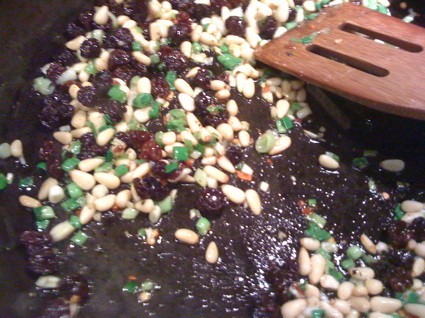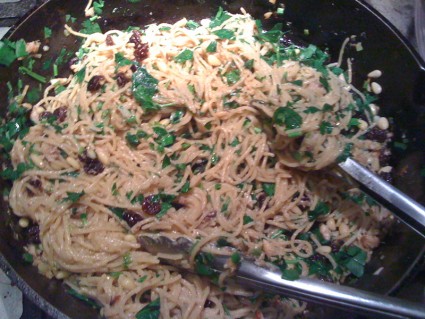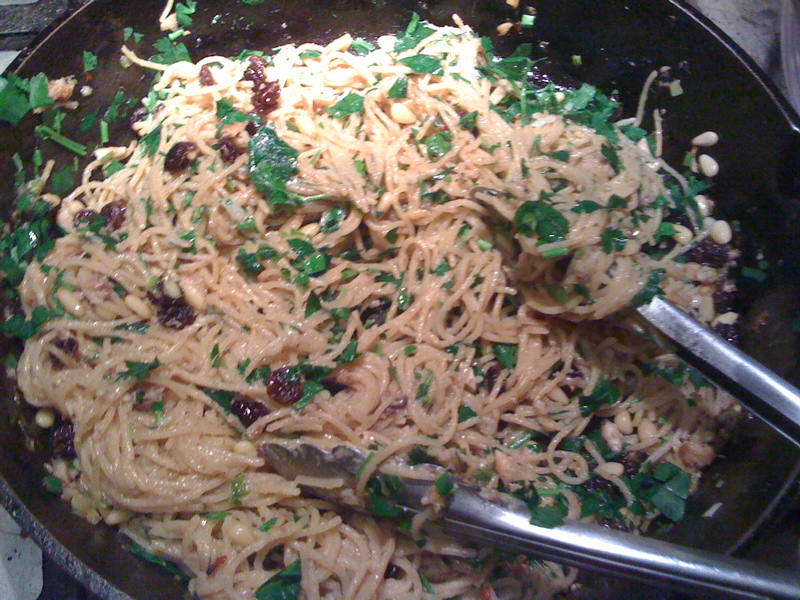 Sardines at a market in Portugal. We’re wasting this magnificent resource on low-quality, mercury-laden farmed salmon? Not in Tom’s Kitchen!
Sardines at a market in Portugal. We’re wasting this magnificent resource on low-quality, mercury-laden farmed salmon? Not in Tom’s Kitchen!
In Tom’s Kitchen, Grist’s food editor discusses some of the quick-and-easy things he gets up to in, well, his kitchen. Forgive him for the lame iPhone photography.
——
A while ago, my colleague Jon Hiskes requested a recipe for sardines. He said he knew he should eat more of them, but didn’t know how to make them in an appealing way. Moreover, his wife, like lots of folks, was predisposed to hate them.
Ah, I thought to myself, I’ve got to make the classic Sicilian dish pasta con sarde for “Tom’s Kitchen.” It’s one of my favorite dishes in the world–and easy, fast, cheap, and highly nourishing, too.
Well, I finally got it together this weekend–only to see that Mark Bittman, The New York Times’ celebrated food writer, had beat me to the punch in his latest Minimalist column.
At first I decided to scrap the idea: anxiety of influence and all of that. But then two events changed my mind. One was news that the United States’ last sardine cannery had closed in Maine. There were several reasons cited for the collapse of the U.S. sardine-canning industry. Lack of domestic demand was a major one. Not even the women who staffed the Maine plant ate the canned delicacies anymore.
Then this post, by Marc Rumminger of the Ethicurean, reminded me of the widespread misuse of highly flavorful and nutritious bottom-feeding fish like sardines. Rather than eating them directly, we’re catching them en masse, churning them into fishmeal, and feeding them to factory-farmed, top-feeding fish like salmon (and also, amazingly, CAFO pigs).
This is nothing short of an ecological crime. According to Taras Grescoe, author of the excellent book Bottomfeeder: How to Eat Ethically in a World of Vanishing Seafood, it take about four pounds of fish like sardines and anchovies to generate a pound of salmon.
Don’t get me started on the various other ills of factory salmon farming. Suffice to say that we would wade a lot more lightly on the ocean if we stopped top-feeding, resource-intensive, filthy salmon farming and simply began to enjoy sardines and anchovies straight from the water–or a can.
Peru has proven that a taste for such fish can develop where it did not exist before. Off of its shores, industrial vessels routinely hoover up vast amounts of anchovetas for the fishmeal industry. Tired of seeing that amazing resource vanish so that U.S. consumers could eat salmon while Peruvian hunger and malnutrition rates remained high, the Peruvian government initiated an effort to promote anchoveta consumption, reports Rumminger.
And it has worked. “By late 2007, demand for fresh anchovies in Peru was up by 46% and demand for canned was up by 85%,” Rumminger reports.
In the spirit of helping make something similar happen here with sardines, I decided to plunge ahead, without reading Bittman’s piece. The world does not need fewer takes on pasta con sarde–or fewer food writers promoting this delectable little fish.
Note well: by switching from farmed salmon and other top feeders to sardines and other so-called “trash fish,” you’re not only helping save the ocean; you’re also getting a rich source of omega-3 fatty acids with (unlike farmed salmon) extremely low levels of mercury.
The key to enticing the sardine-suspicious is to acknowledge that sardines have a strong, pungent flavor–and, counter-intuitively, to pair them with other strong, pungent flavors. I’ve learned a similar lesson with wild watercress, which is now emerging from around the creek of Maverick Farms. Watercress can be piercingly peppery, turning some folks off. Dress it with fresh lemon juice and a little garlic, and it becomes tame and appealing.
That’s what the Sicilians have done with pasta con sarde. With a powerful hit of garlic, the sting of chile pepper, a shock of sweetness from raisins, the richness of pine nuts (and/or walnuts), and a whole lot of chopped parsley, sardines provide the robust backdrop to a glorious cacophony of flavors.
This version isn’t strictly authentic; when I’ve had the dish in Sicily, I’m pretty sure it was made with fresh sardines. I have to confess that this preparation is one I’ve improvised based on one fantastic example I encountered at a small restaurant near Palermo’s outdoor market seven years ago. So purists may find me doing things that simply aren’t done in Sicily. But this version will more than do in a pinch.
Pasta con sarde, Tom’s Kitchen-style
 The mise en place. Those onion-looking things are immature garlic.Photo: Tom PhilpottMise en place: one pound whole-wheat spaghetti (see note, below); two 3.75 oz. tins of sardines packed in olive oil, opened; 1/2 cup total pine nuts and/or coarsely chopped walnuts; 1/4 cup raisins; extra-virgin olive oil; 3-4 cloves of garlic, minced (I used some young green garlic from the garden); one bunch parsley, chopped; some chile pepper flakes; good sea salt; a loaded pepper grinder.
The mise en place. Those onion-looking things are immature garlic.Photo: Tom PhilpottMise en place: one pound whole-wheat spaghetti (see note, below); two 3.75 oz. tins of sardines packed in olive oil, opened; 1/2 cup total pine nuts and/or coarsely chopped walnuts; 1/4 cup raisins; extra-virgin olive oil; 3-4 cloves of garlic, minced (I used some young green garlic from the garden); one bunch parsley, chopped; some chile pepper flakes; good sea salt; a loaded pepper grinder.
Note: I have almost completely lost interest in white flour, and have shifted to whole-wheat pasta. At first, I didn’t like the flavor; now, I find that it stands up to and complements strong-flavored sauces, and use it with pleasure.
Start pasta according to this revolutionary 2009 article by the food-science expert Harold McGee. Add 1 pound spaghetti to a good-sized pot; add 8 cups water and 2 teaspoons of salt. Turn heat to high. Keep an eye on the pot, stirring occasionally as it begins to boil.
 Snap, crackle, and pop: raisins and pinenuts saute with garlic and chile. Photo: Tom PhilpottMeanwhile, put your largest cast-iron (or other kind of) skillet on the stove over low heat. Add just enough olive oil to cover the bottom of the pan. Add chopped garlic and a good pinch of chile pepper, giving it a stir. When the garlic begins to give off its aroma, turn heat to medium and add the nuts. Saute them, stirring often, until they crisp, a minute or two. Now add the raisins and a good pinch of salt. (Be cautious with salt in this recipe; the canned sardines are salted.) Saute the raisins a bit, allowing them to puff up and take in the flavors.
Snap, crackle, and pop: raisins and pinenuts saute with garlic and chile. Photo: Tom PhilpottMeanwhile, put your largest cast-iron (or other kind of) skillet on the stove over low heat. Add just enough olive oil to cover the bottom of the pan. Add chopped garlic and a good pinch of chile pepper, giving it a stir. When the garlic begins to give off its aroma, turn heat to medium and add the nuts. Saute them, stirring often, until they crisp, a minute or two. Now add the raisins and a good pinch of salt. (Be cautious with salt in this recipe; the canned sardines are salted.) Saute the raisins a bit, allowing them to puff up and take in the flavors.
Now, with a fork, lift the sardines from the cans in several batches, letting their oil drain a bit, and drop them in the pan. Give them a good stir, letting them saute for a few seconds; and then, with a wooden spoon, mash them into small pieces. If some raisins and nuts get mashed in the process, all the better. Turn heat to lowest setting while you deal with the pasta.
 You’ll note, especially if you’re using whole wheat pasta, that the water is turning thick and murky. This is a culinary resource–a bit of it it will add an extra dimension to the sauce. So when the pasta is just done, drain it in such a way that you can reserve a cup or so of the water.
You’ll note, especially if you’re using whole wheat pasta, that the water is turning thick and murky. This is a culinary resource–a bit of it it will add an extra dimension to the sauce. So when the pasta is just done, drain it in such a way that you can reserve a cup or so of the water.
When you’ve drained the pasta and reserved some water, empty the pasta pan and return the pasta to it. Dump the sardine mixture on top. Add a drizzle of olive oil, the chopped parsley, about half of the reserved pasta water, and a vigorous grind of black pepper. Toss. Taste for salt. If it needs a little, add the rest of the pasta water. Serve–and enjoy.
Note: this is an extremely wine-friendly dish; it almost demands wine. For recommendations, I turned to Jay Murrie, the wine buyer for Chapel Hill-based 3 Cups. 3 Cups is one of those new-wave wine shops with small, carefully chosen selections focusing on wines made in small batches with minimal manipulation, usually on the farm where the grapes are grown. These tend not to be the rather homogeneous “jammy fruit bombs” favored by the likes of Robert Parker and The Wine Spectator, but rather subtle, interesting wines in a variety of styles that reflect the place they’re from. Here’s what Jay came up with:
• 2007 Colli della Murgia Erbaceo $14.99 Certified organic blend of 60% Fiano Minutolo and 40% Greco from Puglia, ripe, rich.
• 2008 Valle dell’ Acate Il Frappato ($16.99). “A light red from southeastern Sicily, practicing organic, bright, refreshing, red currant & cranberry aromas.” [Jay got me hooked on this gorgeous wine last summer.]
• 2007 Comte Peraldi Vermentino ($19.99). from Corsica. “Smells a little like pine nuts. Fresh but has some substance to it as well.”
• 2007 Do Ferreiro Rebisaca ($16.99). “Because not all wines that are good with pasta con sarde are Italian. Organic, 75% Albarino & 25% Treixadura from the coast of Galicia. Very seafood-friendly”



